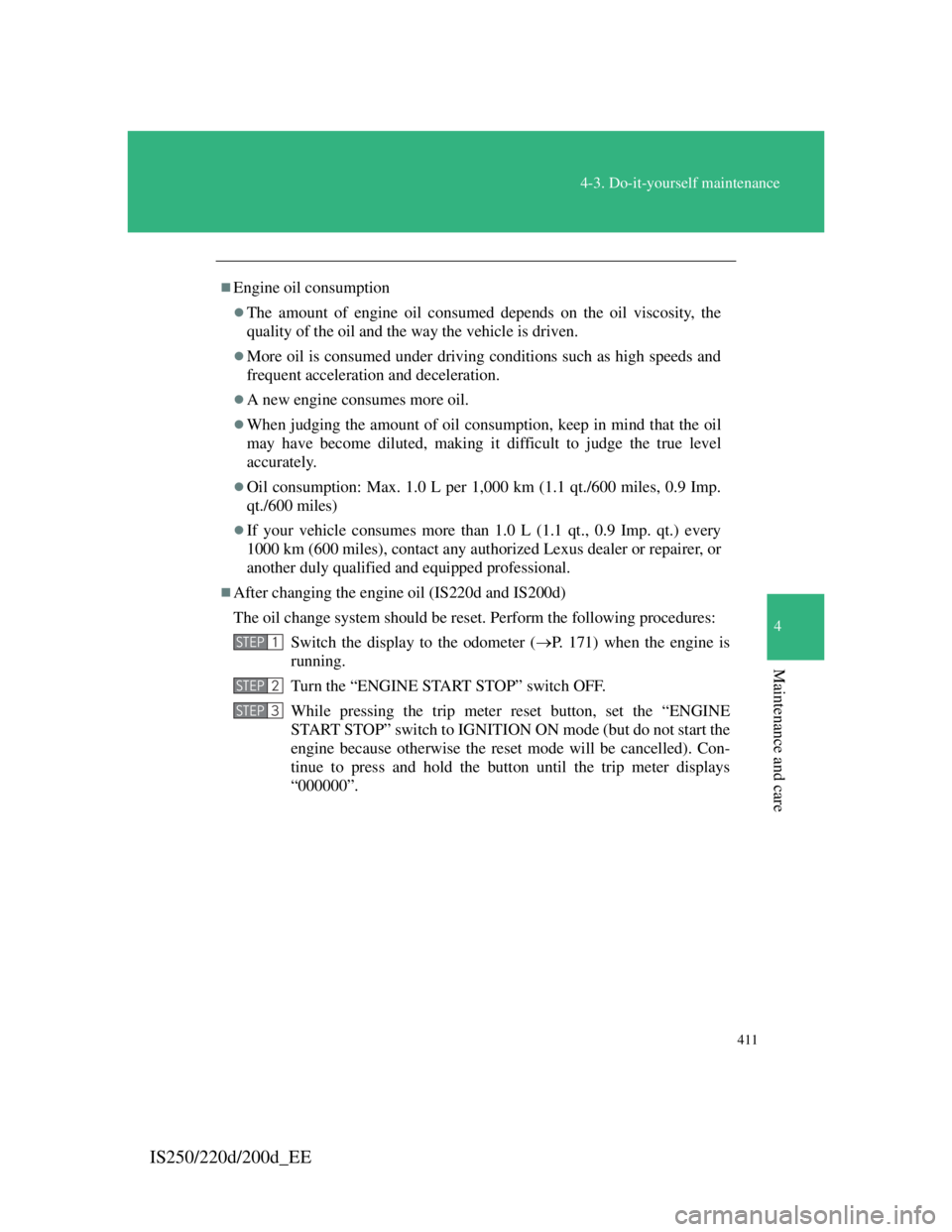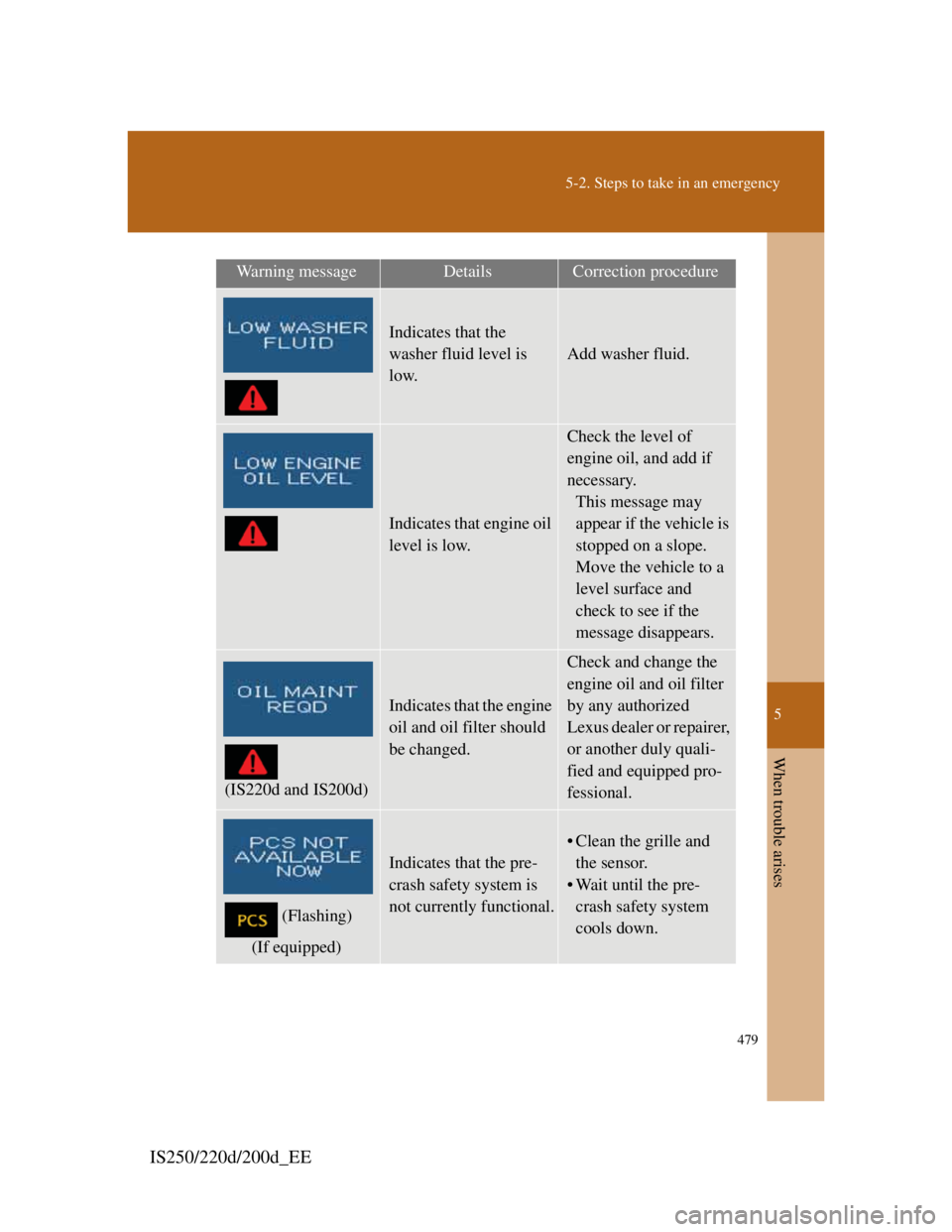oil change Lexus IS220d 2011 Owner's Manual
[x] Cancel search | Manufacturer: LEXUS, Model Year: 2011, Model line: IS220d, Model: Lexus IS220d 2011Pages: 609, PDF Size: 14.63 MB
Page 164 of 609

155
2-1. Driving procedures
2
When driving
IS250/220d/200d_EE
NOTICE
If you get a flat tire while driving
A flat or damaged tire may cause the following situations. Hold the steering
wheel firmly and gradually press the brake pedal to slow down the vehicle.
It may be difficult to control your vehicle.
The vehicle will make abnormal sounds.
The vehicle will behave abnormally.
Information on what to do in case of a flat tire (P. 485, 497)
When encountering flooded roads
Do not drive on a road that has flooded after heavy rain etc. Doing so may
cause the following serious damage to the vehicle.
Engine stalling
Short in electrical components
Engine damage caused by water immersion
In the event that you drive on a flooded road and the vehicle is flooded, be
sure to have any authorized Lexus dealer or repairer, or another duly quali-
fied and equipped professional check the following.
Brake function
Changes in quantity and quality of oil and fluid used for the engine, trans-
mission, differential, etc.
Lubricant condition for the propeller shaft, bearings and suspension joints
(where possible) and the function of all joints, bearings, etc.
Page 432 of 609

411
4-3. Do-it-yourself maintenance
4
Maintenance and care
IS250/220d/200d_EE
Engine oil consumption
The amount of engine oil consumed depends on the oil viscosity, the
quality of the oil and the way the vehicle is driven.
More oil is consumed under driving conditions such as high speeds and
frequent acceleration and deceleration.
A new engine consumes more oil.
When judging the amount of oil consumption, keep in mind that the oil
may have become diluted, making it difficult to judge the true level
accurately.
Oil consumption: Max. 1.0 L per 1,000 km (1.1 qt./600 miles, 0.9 Imp.
qt./600 miles)
If your vehicle consumes more than 1.0 L (1.1 qt., 0.9 Imp. qt.) every
1000 km (600 miles), contact any authorized Lexus dealer or repairer, or
another duly qualified and equipped professional.
After changing the engine oil (IS220d and IS200d)
The oil change system should be reset. Perform the following procedures:
Switch the display to the odometer (P. 171) when the engine is
running.
Turn the “ENGINE START STOP” switch OFF.
While pressing the trip meter reset button, set the “ENGINE
START STOP” switch to IGNITION ON mode (but do not start the
engine because otherwise the reset mode will be cancelled). Con-
tinue to press and hold the button until the trip meter displays
“000000”.
STEP1
STEP2
STEP3
Page 505 of 609

5
479
5-2. Steps to take in an emergency
When trouble arises
IS250/220d/200d_EE
Indicates that the
washer fluid level is
low.
Add washer fluid.
Indicates that engine oil
level is low.
Check the level of
engine oil, and add if
necessary.
This message may
appear if the vehicle is
stopped on a slope.
Move the vehicle to a
level surface and
check to see if the
message disappears.
(IS220d and IS200d)
Indicates that the engine
oil and oil filter should
be changed.
Check and change the
engine oil and oil filter
by any authorized
Lexus dealer or repairer,
or another duly quali-
fied and equipped pro-
fessional.
(Flashing)
(If equipped)
Indicates that the pre-
crash safety system is
not currently functional.
• Clean the grille and
the sensor.
• Wait until the pre-
crash safety system
cools down.
Warning messageDetailsCorrection procedure
Page 570 of 609

540
6-1. Specifications
IS250/220d/200d_EERecommended viscosity (SAE):
SAE 0W-20 is filled into your
Lexus vehicle at manufactur-
ing, and the best choice for
good fuel economy and good
starting in cold weather.
If SAE 0W-20 oil is not avail-
able, SAE 5W-30 oil may be
used. However, it should be
replaced with SAE 0W-20 at
the next oil change.
If you use SAE 10W-30 or a
higher viscosity engine oil in
extremely low temperatures,
the engine may become diffi-
cult to start, so SAE 5W-30 or
lower viscosity engine oil is
recommended.
Oil viscosity (0W-20 is explained here as an example):
• The 0W in 0W-20 indicates the characteristic of the oil which
allows cold startability. Oils with a lower value before the W allow
for easier starting of the engine in cold weather.
• The 20 in 0W-20 indicates the viscosity characteristic of the oil
when the oil is at high temperature. An oil with a higher viscosity
(one with a higher value) may be better suited if the vehicle is oper-
ated at high speeds, or under extreme load conditions.
Temperature range anticipated
before next oil change.
Preferred
Page 573 of 609

543
6-1. Specifications
6
Vehicle specifica-
IS250/220d/200d_EERecommended viscosity (SAE):
SAE 0W-30 is filled into your
Lexus vehicle at manufactur-
ing, and the best choice for
good fuel economy and good
starting in cold weather.
Oil viscosity (0W-30 is explained here as an example):
• The 0W in 0W-30 indicates the characteristic of the oil which
allows cold startability. Oils with a lower value before the W allow
for easier starting of the engine in cold weather.
• The 30 in 0W-30 indicates the viscosity characteristic of the oil
when the oil is at high temperature. An oil with a higher viscosity
(one with a higher value) may be better suited if the vehicle is oper-
ated at high speeds, or under extreme load conditions.
Temperature range anticipated
before next oil change.